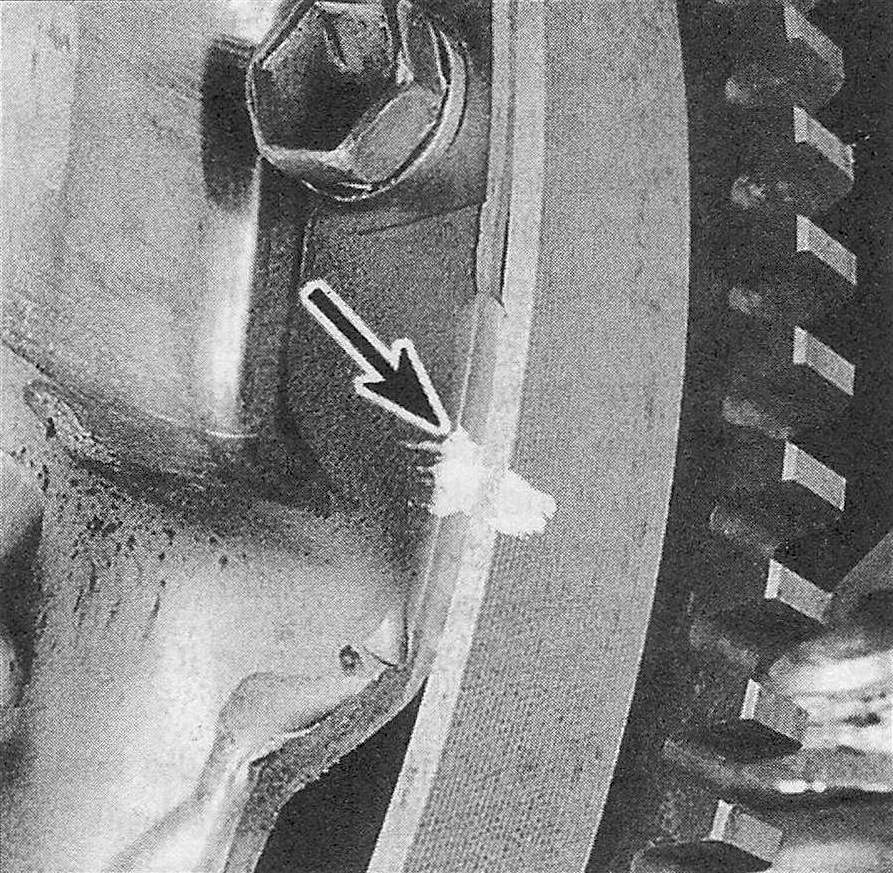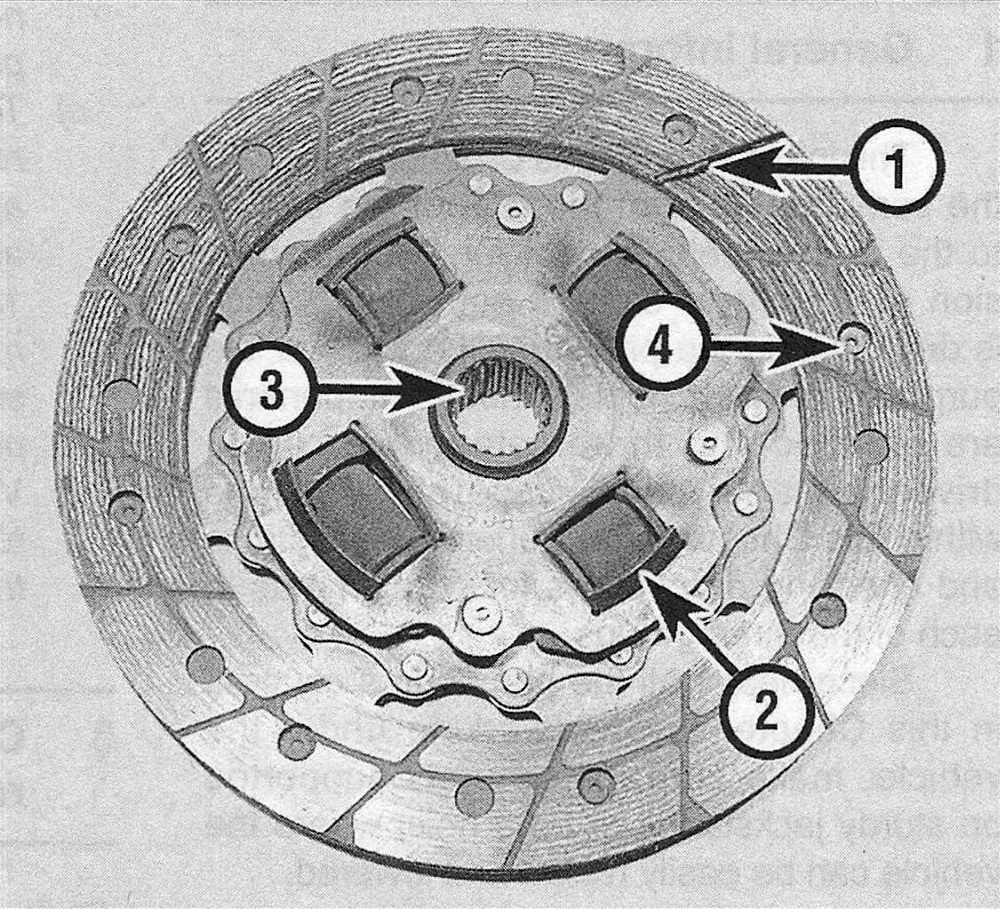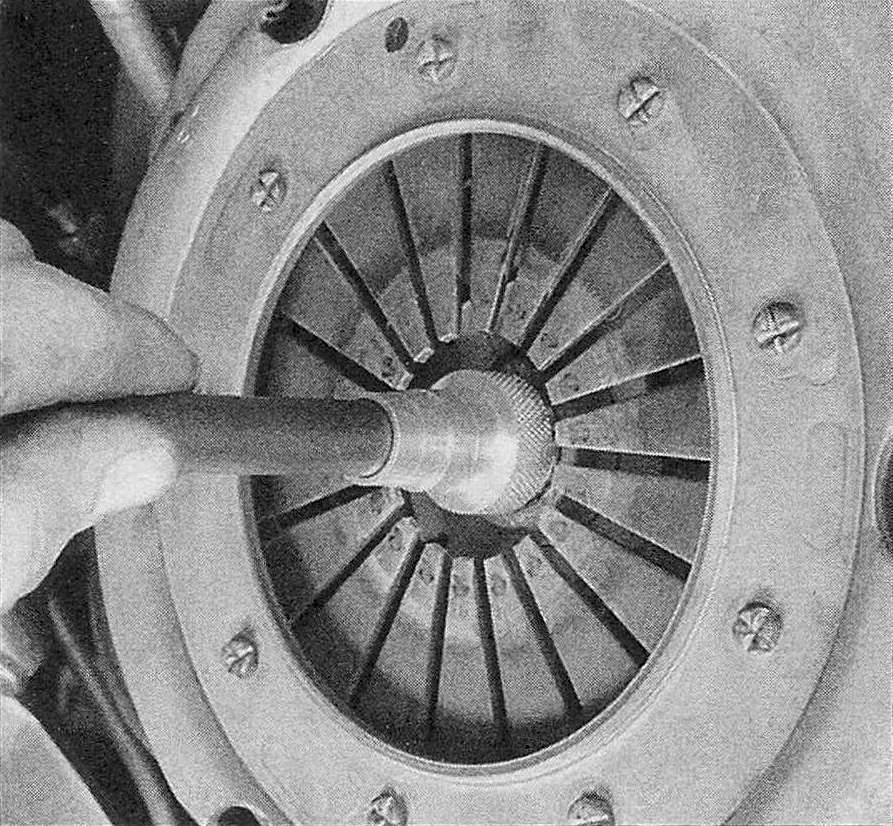Clutch components – removal, inspection and installation
Warning: Dust produced by clutch wear and deposited on clutch components is hazardous to your health. DO NOT blow it out with compressed air and DO NOT inhale it. DO NOT use gasoline or petroleum-based solvents to remove the dust. Brake system cleaner should be used to flush the dust into a drain pan. After the clutch components are wiped clean with a rag, dispose of the contaminated rags and cleaner in a covered, marked container.
Removal
1. Access to the clutch components is normally accomplished by removing the transmission and clutch housing, leaving the engine in the vehicle. If, of course, the engine is being removed for major overhaul, then check the clutch for wear and replace worn components as necessary. However, the relatively low cost of the clutch components compared to the time and trouble spent gaining access to them warrants their replacement anytime the engine or transmission is removed, unless they are new or in near-perfect condition. The following procedures are based on the assumption the engine will stay in place.
2. Raise the vehicle and support it securely on jackstands.
3. Detach the clutch release cylinder from the clutch housing (Clutch hydraulic release system – removal and installation). Caution: Do not disconnect the clutch hydraulic fluid line from the release cylinder. The hydraulic release system cannot be bled if air is allowed to enter the system.
4. Remove the transmission (see Manual transmission).
5. The clutch fork and release bearing can remain attached to the clutch housing for the time being.
6. To support the clutch disc during removal, install a clutch alignment tool through the clutch disc hub.
7. Carefully inspect the flywheel and pressure plate for indexing marks. The marks are usually an X, an 0 or a white letter. If they cannot be found, scribe marks yourself so the pressure plate and the flywheel will be in the same alignment during installation (see illustration).
4.7 Mark the relationship of the pressure plate to the flywheel (if you’re planning to re-use the old pressure plate)
8. Turning each bolt only 1/4-turn at a time, loosen the pressure plate-to-flywheel bolts. Work in a criss-cross pattern until all spring pressure is relieved. Then hold the pressure plate securely and completely remove the bolts, followed by the pressure plate and clutch disc.
Inspection
9. Ordinarily, when a problem occurs in the clutch, it can be attributed to wear of the clutch driven plate assembly (clutch disc). However, all components should be inspected at this time.
10. Inspect the flywheel for cracks, heat checking, grooves and other obvious defects. If the imperfections are slight, a machine shop can machine the surface flat and smooth, which is highly recommended regardless of the surface appearance. Refer to Hemi engine Diesel engine 3.6L V6 engine for the flywheel removal and installation procedure.
11. Inspect the lining on the clutch disc.
There should be at least 1/16-inch of lining above the rivet heads. Check for loose rivets, distortion, cracks, broken springs and other obvious damage (see illustration). As mentioned above, ordinarily the clutch disc is routinely replaced, so if in doubt about the condition, replace it with a new one.
4.11 The clutch disc
1. Lining – this will wear down in use
2. Springs or dampers -check for cracking and deformation
3. Splined hub – the splines must not be worn and should slide smoothly on the transmission input shaft splines
4. Rivets – these secure the lining and will damage the flywheel or pressure plate if allowed to contact the surfaces
12. The release bearing should also be replaced along with the clutch disc (Clutch release bearing – removal, inspection and installation).
13. Check the machined surfaces and the diaphragm spring fingers of the pressure plate (see illustrations). If the surface is grooved or otherwise damaged, replace the pressure plate. Also check for obvious damage, distortion, cracking, etc. Light glazing can be removed with emery cloth or sandpaper. If a new pressure plate is required, new and re-manufactured units are available.
4.13a Replace the pressure plate if excessive wear or damage is noted
4.13b Inspect the pressure plate surface for excessive score marks, cracks and signs of overheating
14. Check the pilot bearing in the end of the crankshaft for excessive wear, scoring, dryness, roughness and any other obvious damage. If any of these conditions are noted, replace the bearing (Pilot bearing – inspection and replacement). Note: Considering the amount of work you’ve done to get to this point, it’s a good idea to go ahead and replace the pilot bearing at this time.
Installation
15. Clean the machined surfaces with lacquer thinner or acetone. It’s important that no oil or grease is on these surfaces or the lining of the clutch disc. Handle the parts only with clean hands. Install the flywheel (see Hemi engine Diesel engine 3.6L V6 engine ).
16. Position the clutch disc and pressure plate against the flywheel. If installing the original pressure plate, align the index marks. Hold the clutch in place with an alignment tool (see illustration). Make sure it’s installed properly (most replacement clutch plates will be marked «flywheel side» or something similar – if it’s not marked, install the clutch disc with the damper springs toward the transmission).
4.16 Center the clutch disc in the pressure plate with an alignment tool before the bolts are tightened
17. Tighten the pressure plate-to-flywheel bolts only finger-tight, working around the pressure plate.
18. Center the clutch disc by ensuring the alignment tool extends through the splined hub and into the pilot bearing in the crankshaft. Wiggle the tool up, down or from sideto-side as needed to bottom the tool in the pilot bearing. Tighten the pressure plate-toflywheel bolts a little at a time, working in a criss-cross pattern, to prevent distorting the cover. After all the bolts are snug, tighten them to the torque listed in this Chapter’s Specifications. Remove the alignment tool.
19. Using high-temperature grease, lubricate the inner groove of the release bearing (Clutch release bearing – removal, inspection and installation). Also place grease on the release lever contact areas and the transmission input shaft bearing retainer.
20. Install the clutch release bearing, if removed (Clutch release bearing – removal, inspection and installation).
21. Install the transmission (see Manual transmission) and all components removed previously.
22. Remove the jackstands and lower the vehicle.




